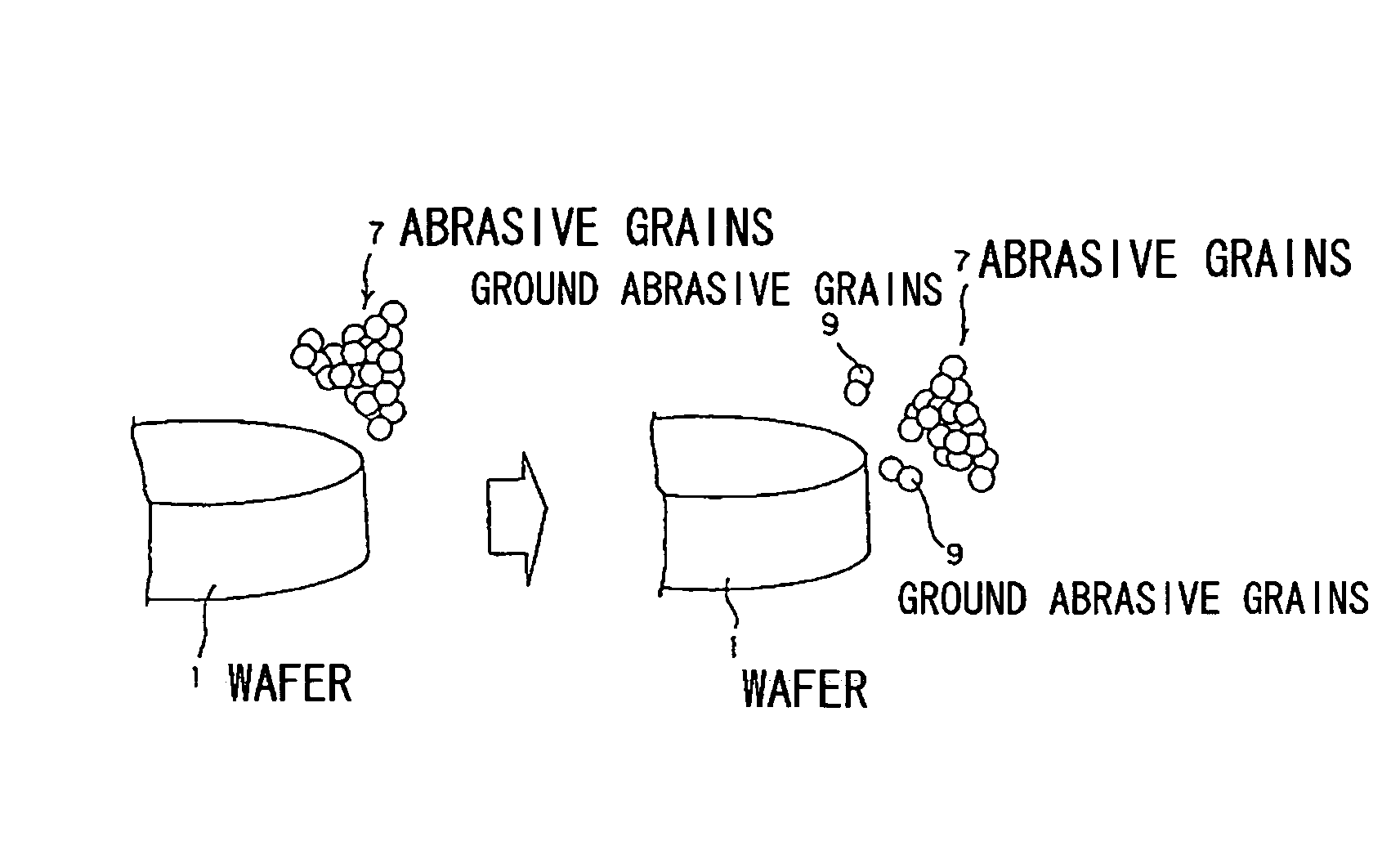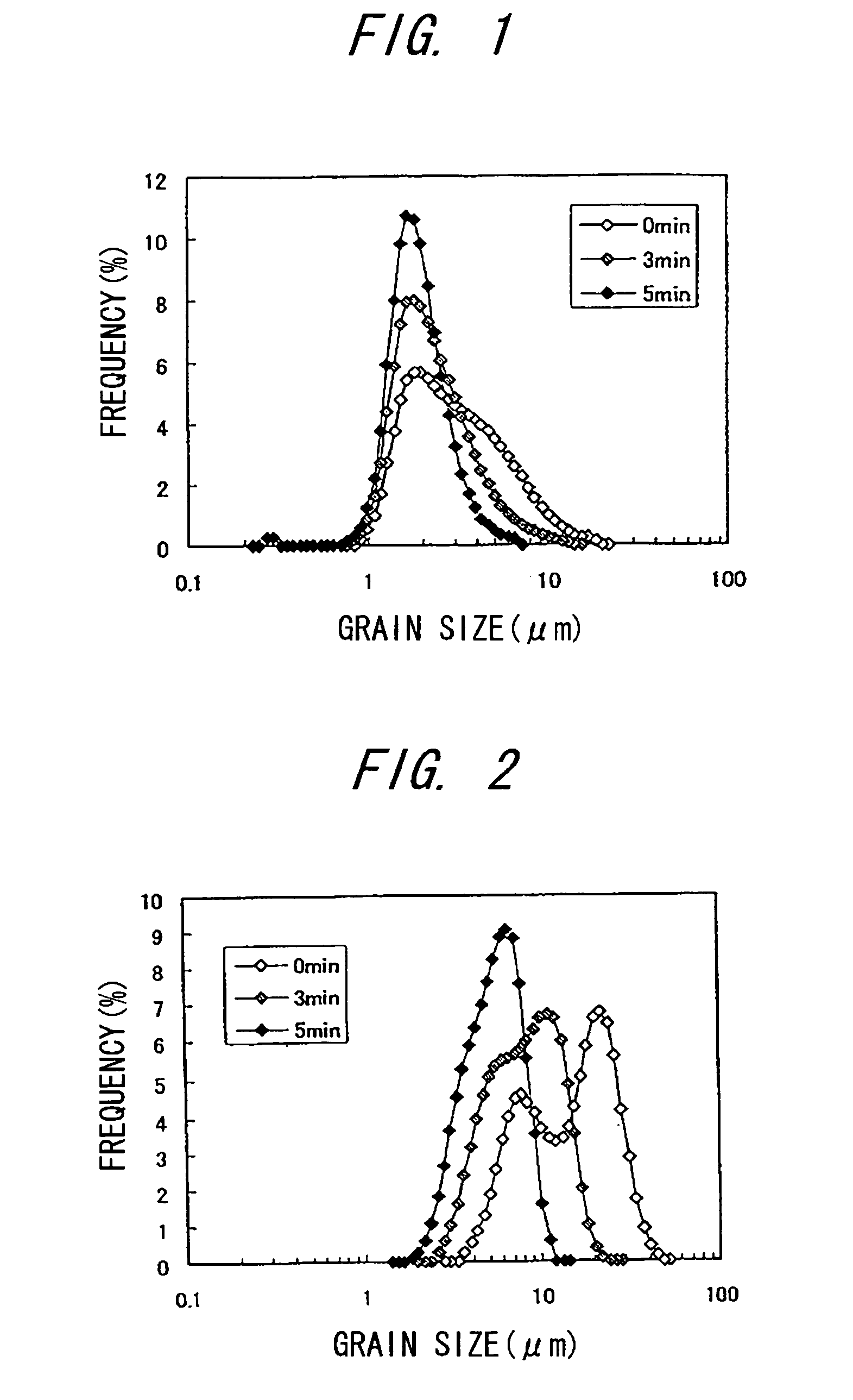Grinding abrasive grains, abrasive, abrasive solution, abrasive solution preparation method, grinding method, and semiconductor device fabrication method
a technology of grinding abrasives and grains, which is applied in the direction of lapping machines, manufacturing tools, other chemical processes, etc., can solve the problems of affecting the quality of wafers, the grinding speed of abrasives is not necessarily faster, and many errors, etc., to achieve high-speed grinding, poor mechanical strength, and strong cleavage
- Summary
- Abstract
- Description
- Claims
- Application Information
AI Technical Summary
Benefits of technology
Problems solved by technology
Method used
Image
Examples
example 1
[0088]This Example examined grinding characteristics of an abrasive dissolved and dispersed in pure water, as shown in Table 1, using silica Nos. 1-7 as abrasive grains.
[0089]
TABLE 1CompositionAbrasive content[wt %]ConcentrationSilica (abrasive grains)2011[g / l]Sodium dichloroisocyanurate350.0082[mol / l]Sodium tripolyphosphate220.03[mol / l]Sodium sulfate180.06[mol / l]Sodium carbonate50.025[mol / l]
[0090]First, silica Nos. 1 and 2 use fumed silica with an average grain size of 50 nm measured by the BET method, and aggregated silica grains are formed in the conditions of Table 2. In forming each aggregated silica, fumed silica as an ingredient and a predetermined amount of pure water are mixed uniformly by a Heichel mixer. Subsequently, aggregated silica No. 1 is hot-air dried for 24 hr at 120° C. in a constant-temperature bath, while aggregated silica No. 2 is heat-dried for 2 hr being uniformly mixed at 100° C. by a Heichel mixer. Nos. 1 and 2 are then ground at 25° C. by a pin mill. Aggr...
example 3
[0122]In order to grasp a life of abrasive pads, after an abrasive is prepared using abrasive grains No. 3 of Example 1, an abrasive solution is prepared, and grinding is performed in the same conditions as those of Example 1 (The results are shown in Table 11).
[0123]
TABLE 11WaferSurfaceSilicaGrindingshaperoughness(abrasiveNo. ofspeed(TTV)(Pv)grains)cycles[μm / min][nm][nm]AppearanceNo. 310.60 or more1.43-5Very good450.60 or more0.853-5Very good(peripheraldripping)No. 6460.58 or more1.34-6Very good950.57 or more1.14-6Good
[0124]The result shows that the wafer shape varies little by little from 20 cycles, and at 45 cycles, peripheral dripping in the wafer is remarkable, while the measured value of TTV is 0.85. For this reason, after an abrasive is prepared using abrasive grains No. 6 so that the concentration of sodium tripolyphosphate is 0.05 mol / l in the same manner as Example 2, an abrasive solution is prepared, and grinding is performed in the same conditions as those of Example 1. ...
example 4
[0125]This Example fabricates a semiconductor laser device with MQW (multi-quantum well) structure provided on a GaAs substrate as one example of a semiconductor device. Further, the form of a semiconductor device fabricated with the invention is not limited to the structure of this Example.
[0126]First, using the abrasive solution of Example 1 shown in Table 3, a surface of the (100)-plane GaAs substrate is ground and flatted. The grinding conditions are almost the same as those shown in Table 4: the grinding pressure is 3.5 kPa; the number of revolutions of the plate is about 74 rpm; the abrasive solution supply is 15 ml / min; and the grinding time is about 60 min.
[0127]Subsequently, grinding marks in the surface of the GaAs substrate are removed using a H3PO4:H2O etching solution according to needs. Thereafter, using MBE (molecular beam epitaxy), MOCVD (metal organic chemical vapor deposition), or the like, there are sequentially formed a first GaAlAs cladding layer (film thickness...
PUM
| Property | Measurement | Unit |
|---|---|---|
| grain size | aaaaa | aaaaa |
| grain size | aaaaa | aaaaa |
| grain size | aaaaa | aaaaa |
Abstract
Description
Claims
Application Information
 Login to View More
Login to View More - R&D
- Intellectual Property
- Life Sciences
- Materials
- Tech Scout
- Unparalleled Data Quality
- Higher Quality Content
- 60% Fewer Hallucinations
Browse by: Latest US Patents, China's latest patents, Technical Efficacy Thesaurus, Application Domain, Technology Topic, Popular Technical Reports.
© 2025 PatSnap. All rights reserved.Legal|Privacy policy|Modern Slavery Act Transparency Statement|Sitemap|About US| Contact US: help@patsnap.com



